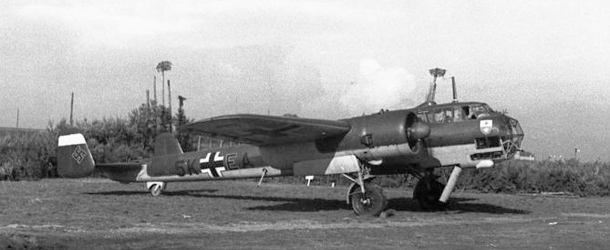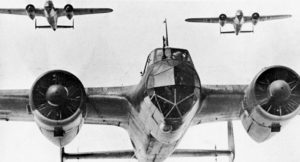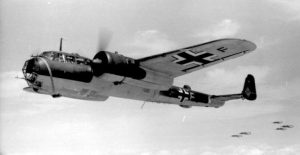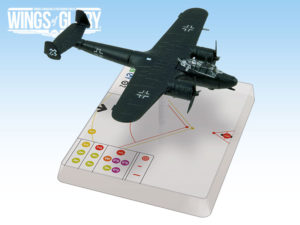Four new Special/Squadron Packs, featuring the bombers Dornier Do.17 and Junkers Ju.88, are coming to WW2 Wings of Glory. Let us learn more about the Dornier Do.17 and its two versions presented in the packs: Do.17 Z-2 and Do.17 Z-10.
Even before Hitler gained power in 1933, the German military had begun a stealthy re-armament program, with cover stories to hide the development of new weapons. What we know today is the Dornier Do.17 began with government requests for a “high speed mail plane” (with room for six passengers—but only barely!) or a “freight aircraft for German State Railways.” Several prototypes met mixed results and the design languished until a Lufthansa pilot received permission to try one and put on what amounted to a stunt flying performance, proclaiming after landing that “the machine is as nimble as a fighter.”
The Do.17 was one of several planes designed as ‘fast bombers,” with the concept being they would be faster than fighter defenses and their speed would allow them to survive with limited defensive armament. The slick lines of the Do.17 led to it being nicknamed “The Flying Pencil.” The concept did not take into account the fact that fighters would increase in speed, and more quickly than the bombers would. As early as the Spanish Civil War, the plane began to receive modifications and additional guns.
In fact, one problem the Do.17 had throughout its lifespan was competing for engines that were continually diverted to fighter designs. The Do.17s would be built with a wide variety of alternative engines, but never fully achieve the safety in speed that was originally desired. All these different engine variants and experiments created a long list of barely manufactured varieties, such that it was the Do.17 Z which became the most-produced model, and further variants were designated with adding numbers to follow the Z letter. Future development would slide into the Do.217, which was similar in exterior appearance but larger and much more powerful.
Slightly over 2100 Dorniers were built, with the Z-2 being the main production model. Only about 200 Do.17s were still operational by the time the Battle of Britain began and their losses were severe. Extra guns were continually added (as many as eight in some planes!), but the 4-man crew did not increase, so gunners were responsible for several machine guns. Gradually replaced by the Ju88, Do.17s were passed on to Axis allies. By the time of Barbarossa, there was only one German squadron still equipped with the type.
Dornier Do.17 in Wings of Glory
The bomber Dornier Do.17 is featured in two Squadron Packs. The first is a Do.17 Z-2, which gives Battle of Britain players a focal point for their scenarios. The bombers are lethal to ground targets but very vulnerable in the air. Fighters must decide the best ways to protect them—a key question the Luftwaffe struggled with during those critical months.
This model includes new ‘target’ cards for attacks on ships, and markings to select from three different planes in KG.76. Kampfgeschwader 76 was one of the few German bomber groups to serve for the entire war. The “Battle Wing” contained three bomber “Gruppe,” though KG.76 began the war with just two but was fully operational in time for the Battle of France and Battle of Britain. Originally equipped with the Do.17, it had fully converted to the Ju.88 early in 1941.
One of the markings offered is the plane for 9 Squadron commander Hauptmann Joachim Roth, who is most remembered for leading an extremely low-level attack against Kenly airfield in what became known as “The Hardest Day” during the Battle of Britain. Both sides suffered heavily in the engagement and Roth was among the casualties. Airplane management cards let you handle crew positions, casualties, and crewmen who shift positions. Special abilities cards include improved bombing abilities, better defensive fire, alternative guns, and faster crew position shifting.
The second model is a Do.17 Z-10. The German military was known for adapting designs to new purposes and getting some use out of any available equipment. Thus, as Britain’s night bombing campaign grew, the Luftwaffe adapted a variety of different planes to combat the incursions.
As the Do.17s lost their usefulness as medium bombers, a few were adapted to other purposes. An earlier Z-6 variant borrowed a nose from an up-gunned Ju.88 for night fighting but the Z-10 used a purpose-built nose with armor to protect the crew plus two cannon and extra machine guns. A few also adapted for slightly less forward firepower but adding the distinctive “Shräge Musik” upwards firing system. “Schräge Musik” is slang for ‘slanted’ music (like experimental jazz) and we can see the connection in the slanted angles of the gun mountings. In fact, a Do-17 was the first German plane fitted with this system as an experiment in late 1942.
The Z-10 provides an early entry into the technology advance of German defenses against night bombing raids. While later planes were more powerful, this was an early step to get some kind of defenses in place, and it had great success in the beginning, in spite of the small numbers used.
The package includes markings to select from three different planes in the Nachtjagdgeschwader 2 (NJG.2, 2nd Night fighter squadron), including squadron commander Erich Jung, who had early success with the Do.17 Schräge Musik technique before moving to Ju.88s. Special cards include powerful pilot abilities and a “replacement pilot” option, plus the chance to turn the plane into the Schräge Musik version.
Information sources: Military Factory, "Bomber Units of the Luftwaffe 1933-1945: A Reference Source, Volume 1", de Zeng, H.L., D.G. Stanket and E.J. Creek, "Aircraft of the Third Reich", Green, William (London, Aerospace Publishing Limited, 2010), "Luftwaffe at War; Gathering Storm 1933-39: Volume 1", Hooton, E.R. (London, Chevron/Ian Allan, 2007).
Images sources: On top: Bundesarchiv, Bild 101I-345-0784-14A / Gentsch / CC-BY-SA 3.0 / CC BY-SA 3.0 DE, * Royal Air Force Battle of Britain campaign diaries, ** Bundesarchiv, Bild 101I-341-0489-10A / Spieth / CC-BY-SA 3.0.













Follow Us on